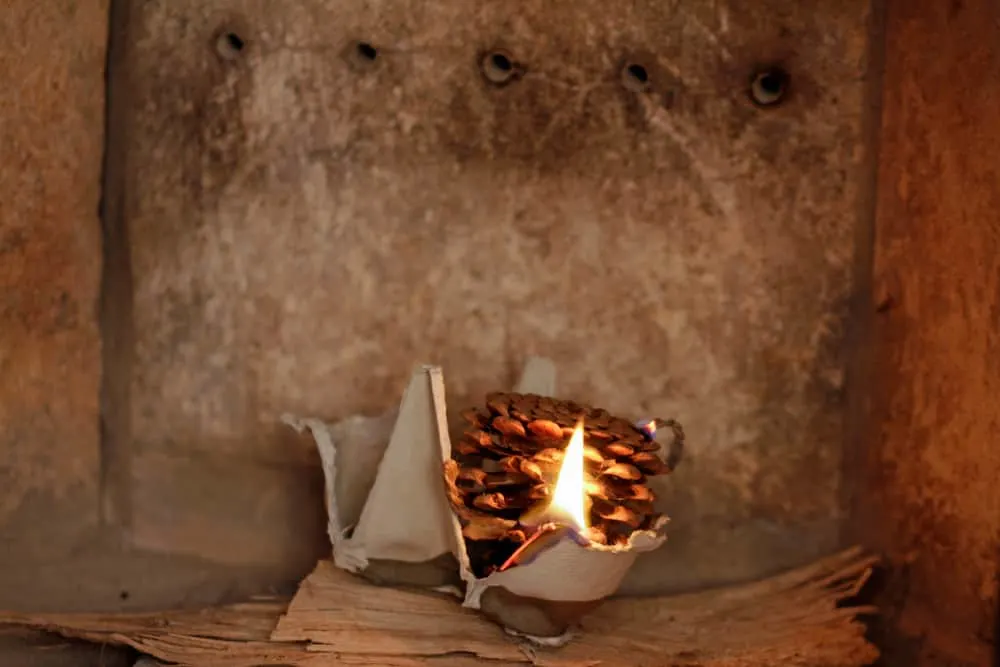
Many homesteads rely on wood-fired stoves or boilers for space and water heating.
Many people also cook in a wood-fired range or regularly do so over an open fire.
Even if you just have the occasional campfire, you will know that getting your fire started is not always an easy thing to do.
Admittedly, those who light fires on a regular basis will soon become a dab hand – learning those little tricks and getting the knack of their own particular firepit, fireplace, stove or range – while also making sure that they are burning the best wood that has been properly seasoned and stored.
But firelighters certainly make the task a whole lot easier!
Eco-friendly firelighters mean that you do not have to feel guilty about your little ‘cheat’.
Firelighters can save a lot of time on busy mornings, or when you come in from the cold after a hard day’s work.
Yes, you can light a fire by rubbing two sticks together – but with all the other jobs on a homestead to contend with – who can really find the time?
Unless you are a woodsman purist, who refuses to take shortcuts and takes pride in the effort and skill required to kindle your logs, it is likely that if you regularly light a fire, firelighters are a part of your life.
They are a practical item – easy to overlook but annoying to be without.
But which firelighters should you choose? Should you buy them, or make your own?
It is worthwhile taking a little time to think about your options, and about how you might be able to make better decisions.
Why Choose Eco-Friendly Firelighters?
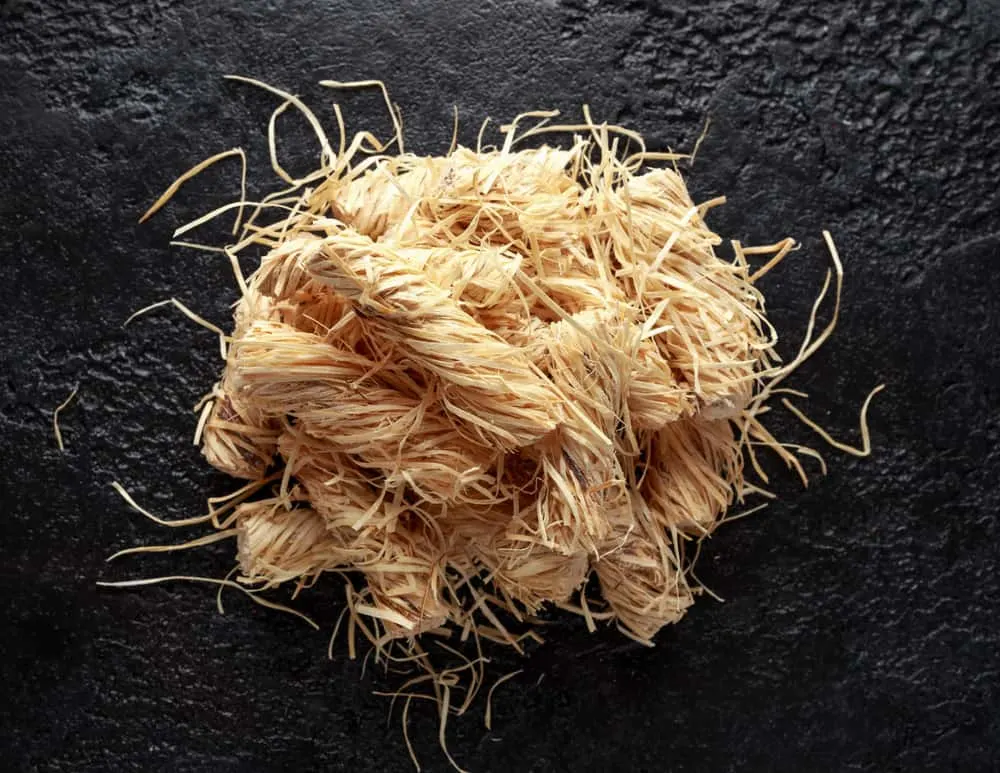
Firelighters always make your job a little easier. Unfortunately, many of the firelighters on the market do so at a cost to our planet and people.
Many of the firelighters that you can buy are made using fossil fuels. Many contain kerosene, paraffin or paraffin wax, all of which are derived from petroleum.
Of course, such options are not sustainable and carry a huge CO2 cost, contributing to global warming.
Some firelighters are also toxic to humans – not something that you should bring into a healthy home.
When burned, certain options (hexamine firelighters) give off formaldehyde-a.
This is a substance which has been classified as a human carcinogen by the International Agency for Research on Cancer (IARC) and as a probable human carcinogen by the U.S. Environmental Protection Agency (EPA).
What is more, analyses have found that many petroleum and hexamine based brand-name firelighters give off a range of other emissions that have been proven to have a detrimental effect on human health.
Vegetable oils are a solution sometimes employed in order to avoid the need for fossil fuels or other toxic substances. But those that contain palm oil are not an eco-friendly solution either.
The problem with palm oil is that the industry directly contributes to the destruction of the Amazon rainforest – one of the most important carbon sinks in the world.
If you are trying to go greener on your homestead, and want to live as sustainably as possible, then it is essential to look carefully at the ingredients in any firelighters that you buy.
Where you do decide to buy firelighters, you should make sure that you choose eco-friendly options.
Should You Buy Eco-Friendly Firelighters, or Make Them?
When it comes to deciding whether to buy or make eco-friendly firelighters, the key thing to think about is the trade off between time and money.
Of course, the decision that you make will depend on your own individual circumstances.
Buying eco-friendly firelighters will cost money, while making your own is something you can do cheaply, or often even for free.
On the other hand, while it is not particularly time consuming to make your own firelighters, it will inevitably require a little time and effort.
It also has to be said that while effective, firelighters that you make at home may not be quite as easy to use or efficient as those you can purchase from eco-friendly firelighter brands.
Whatever you decide, it is worthwhile also thinking about the environmental cost of your choice.
Bear in mind that even the most eco-friendly option out there will have to travel to reach you.
Transportation will almost certainly cause some C02 emissions.
There is also the packaging to consider, and it is the most eco-friendly option to avoid options that come in plastic packaging.
5 Eco Friendly Firelighters You Could Buy
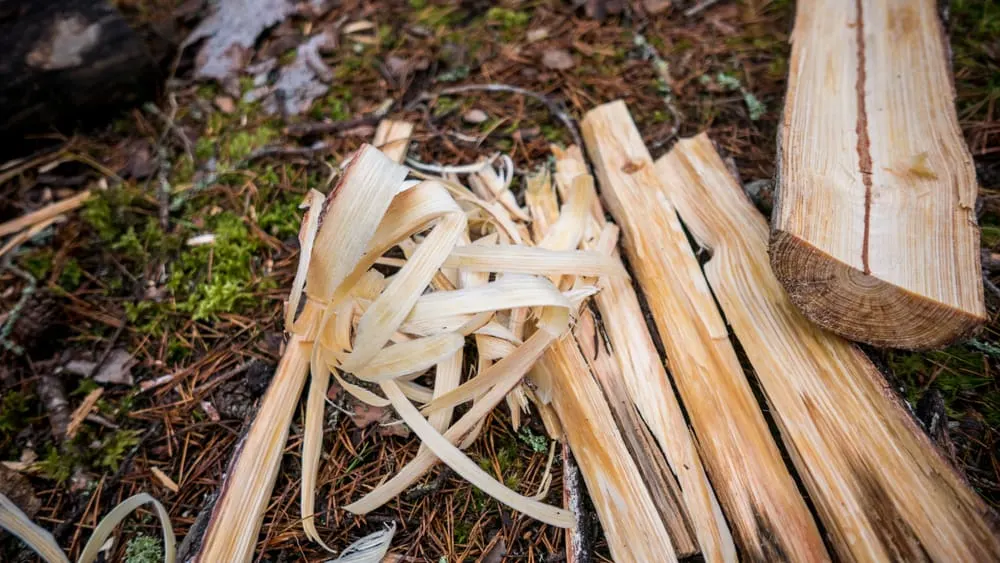
There are a number of different fire starters out there than refer to themselves as ‘green’ – some better than others.
Here are five of the top options to consider:
1. GrillTrade Eco Friendly Fire Starter

These fire starters are made from mountain pine shavings rolled into cylindrical shapes and dipped into wax.
No chemicals are used and these can easily be lit without paper.
If you want something a little larger you could also go for the ‘Woolly Mammoth’ fire starter from the same brand.
2. GreenSpark Fire Starter

These are another all-natural option.
These efficient firelighters are easy to use, lightweight, odorless, and non-toxic.
Each one will burn for 8-10 minutes and there are around 160 in a box, so they should last you a while.
3. Natural Light Co. Fire Starter

Made from the leftover wicks from a beeswax candle factory, these firelighters are made from 100% organic beeswax and cotton.
You only need a small amount to start a fire and it will last for a few minutes before it burns out.
4. TnT Fatwood Fire Starter Sticks

If you are not lucky enough to have a source of fatwood on your property, you may be amazed by the fire-starting capacity of this naturally resinated wood.
For those unfamiliar with fatwood, it is wood from the head of pine tree stumps – no wax, no toxins – just nature.
If you can source fatwood close to where you live then this is definitely my number one pick.
5. Mayan Flame Fatwood Fire Starters

Here is another source of fatwood firelighters.
No trees are cut down for this eco friendly option, so you can just relax, and get your blaze going in no time.
Fatwood sticks can get a fire going almost instantly – it really could not be easier.
It might be referred to as the ‘green yuppie fire starter’ but could be a great solution for many homes.
How To Make Your Own Eco Friendly Firelighters
Of course, if you have your own source of fatwood, then you are onto a winner right away. But most of us are not lucky enough to have access to this useful fire starting resource.
But that is not to say that we do not have access to other local resources that we can use.
There are a number of different ingredients to make your own eco-friendly fire starters that you can find on your very own property.
Our ancestors, of course, would simply have used whatever came to hand to get their fires started, and we can do the same.
We can use natural materials from our land/ gardens, and/or utilise waste materials from our homes.
Natural Materials for Firelighters
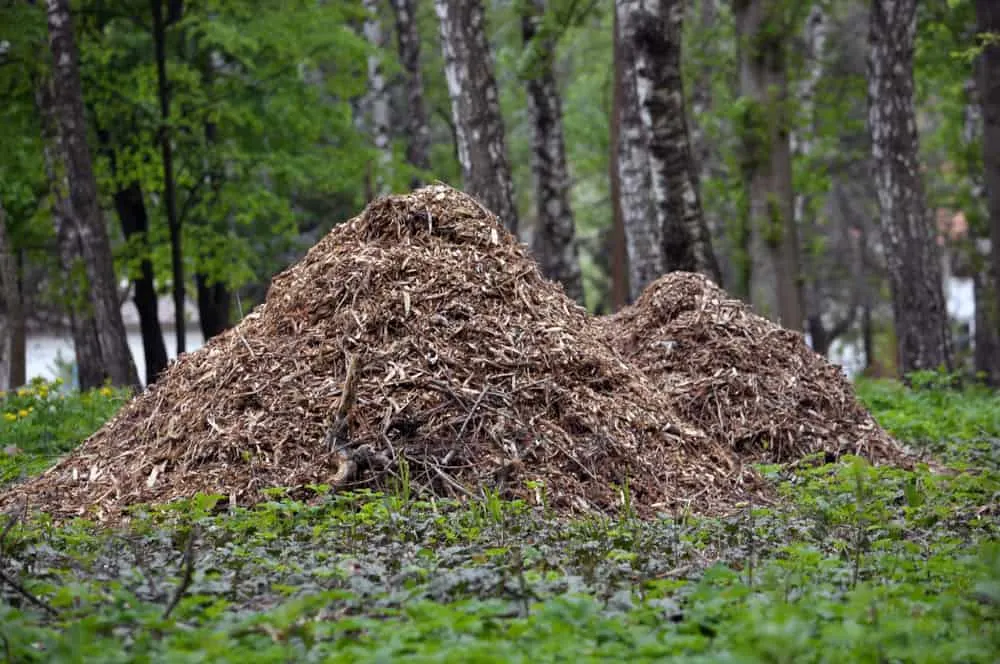
Here on our property, we have firewood logs delivered to us from our neighbours. (They are simply delivered over our boundary wall.)
Our property is not large enough to give us all the wood we need – but this wood, from sustainably managed woodland literally feet away, is the next best thing.
We do supplement this main supply with wood from our own land – pruned branches from our orchard etc… Nothing is wasted and we make use of all the wood that is cut or falls from trees on our land.
We have a plentiful supply of kindling material and smaller branches, and also wood chip generated by passing brush through a garden shredder.
While much of the wood chip is used throughout the garden and orchard areas, we also use some of it to make firelighters. We also make use of the sawdust generated by processing the firewood that is delivered.
Not everyone will have access to wood chip and sawdust for firelighters.
However, you may be able to make use of other natural materials to make firelighters. For example, you might be able to gather:
- Pinecones
- Pine needles / dry leaves
- Bark fibres
- Dried grass or bracken
- Certain fungi (Fomes fomentarius, for example – be sure to be judicious in harvesting, take only what you need and allow the fungus to regenerate.)
- Raw sheep’s wool / other animal fibres.
Waste Materials for Firelighters
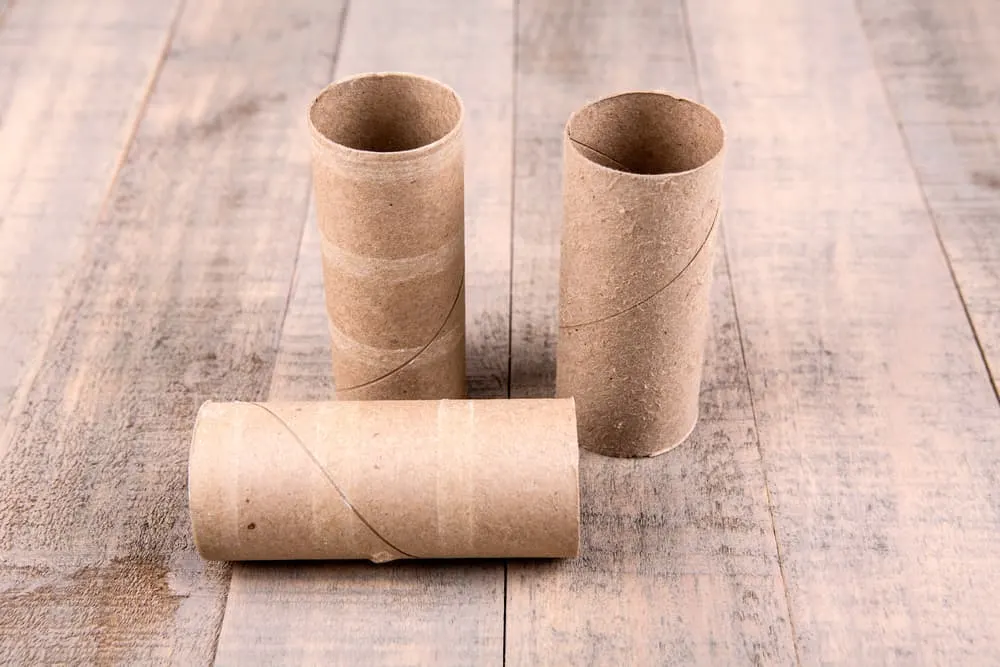
When I was a child, my parents simply used to use a twist of newspaper to get the fire started. But of course, newspapers are no longer the ubiquitous item that they once were.
Far fewer people have newspapers delivered, or buy them on a regular basis. So this option might not be open to you.
However, it is likely that you will have a number of other items that you could use. For example, you could make use of:
- Toilet roll tubes
- Egg cartons
- Torn/shredded cardboard boxes
- Shredded paper (untreated and plastic free papers only)
- Wine corks
- Dried, used teabags (as long as they are plastic free).
- Unravelled jute/hemp twine
- Dried orange peel – here’s a tutorial for making firestarters out of orange peel
You could simply use natural or waste materials as tinder on their own.
But firelighters that make firelighting even easier can be made by adding some wax to some of the materials mentioned above.
Wax For DIY Firelighters
Since we are trying to avoid fossil fuel derived products wherever possible, we avoid using paraffin wax and make candles (and firelighters) using natural beeswax.
Of course, if you are a beekeeper, this is another thing that you might be able to source for free on your homestead.
If you render fat from livestock reared on your homestead, then making tallow candles and firelighters could also be an option.
One of the great things about making your own DIY firelighters is that you can use wax from candle bases that are soot blackened or dirty – thereby making use of all the wax that could not be recycled to make new candles.
You may also be able to use the stubs of candle wicks to make it easier to light your firelighters.
Melting Your Wax
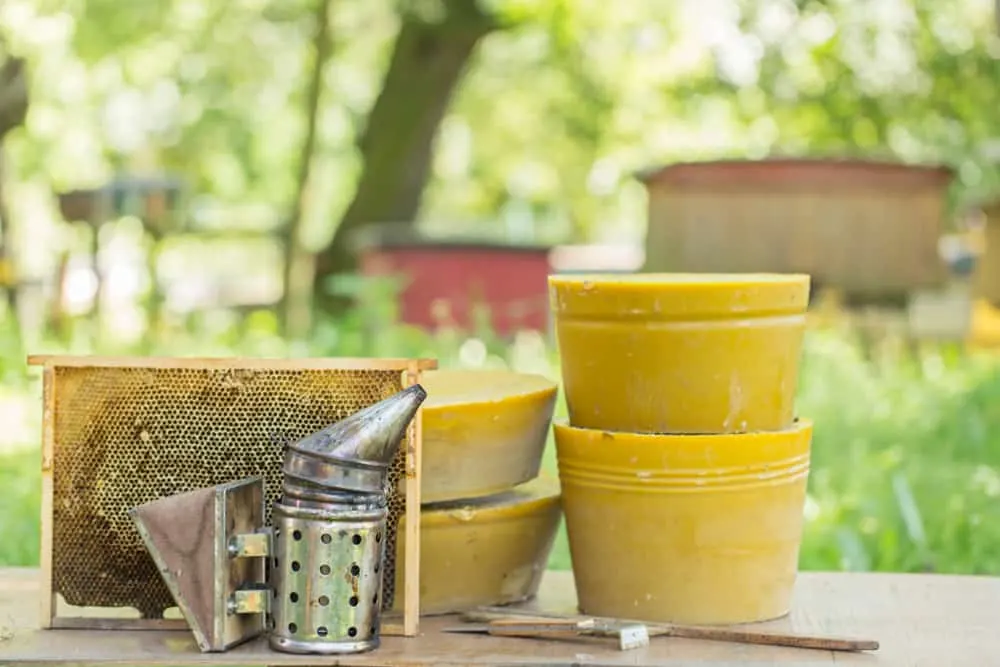
Once you have sourced or collected your beeswax (or gathered up old candle ends), and gathered the tinder for your firelighters, it is time to melt the wax so that it can be poured over or used to coat the materials.
There are several different ways in which you can do this. You can:
- Melt the wax in a bowl over a pan on the stove top.
- Place beeswax pieces into an old muffin tray, and melt in the oven.
Once you have melted your wax, it is time to add it to the tinder materials, or to add the tinder materials to it.
Forming Your Firelighters
There are no hard and fast rules about how you should combine the wax and tinder materials to form your firelighters, and a number of different options that you could choose.
Generally speaking, you are looking to form a thin coating of wax that will bind the tightly packed tinder materials together to form your firelighters.
You can experiment with the proportions or wax and other materials to see what works best for you.
Personally, I have used two different methods to form our wax, wood chip and sawdust firelighters.
The first is to fold over the end of toilet roll tubes, stuff these full with wood chip and sawdust, then pour in wax to just cover the contents.
I prop these tubes upright to set before storing them securely.
The second method, which is even easier, is simply using an old spoon to push wood and sawdust down into the melted wax in the compartments in an old muffin tray.
I also insert short wicks into the sides of these to make them easier to light.
Once these are set, I slide a knife around the edges of the firelighters to remove them from the tray.
If you find them challenging to remove, you could consider using paper cake cases or baking parchment to line the compartments. (Just be sure to choose plastic-free options.)
Making our own firelighters allows us to make use of natural and waste materials from our property and personally, I find it an enjoyable process.
But whether you make them or buy them, eco-friendly firelighters certainly make lighting fires a whole lot quicker and easier.
And while we are on the top of making your fire more eco-friendly, why not learn some of the brilliant ways to put your fireplace wood ash to good use.
Pin This To Save For Later
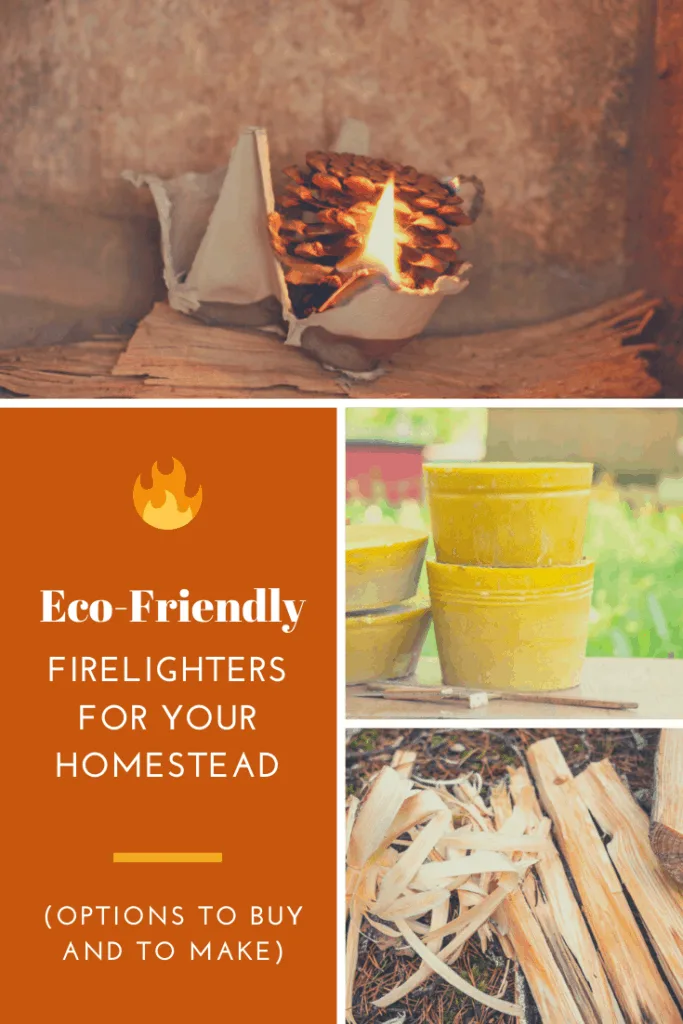

Get the famous Rural Sprout newsletter delivered to your inbox.
Including Sunday ramblings from our editor, Tracey, as well as “What’s Up Wednesday” our roundup of what’s in season and new article updates and alerts.


